
http://www.umn.edu/urelate
612-624-6868

Highlights from SRD 2017
Spring Research Day (SRD) is our annual all–day, university–wide symposium that showcases the work of graduate students. This year, we invited all University of Minnesota graduate students to submit abstracts for posters or 10-to-15 minute oral presentations. Participants presented developing research ideas from a wide range of departments and programs.
"Grounding Mathematics in Formal Ideas : An Empirical Synthesis"- Purav Patel, Sashank Varma (847kb pdf)
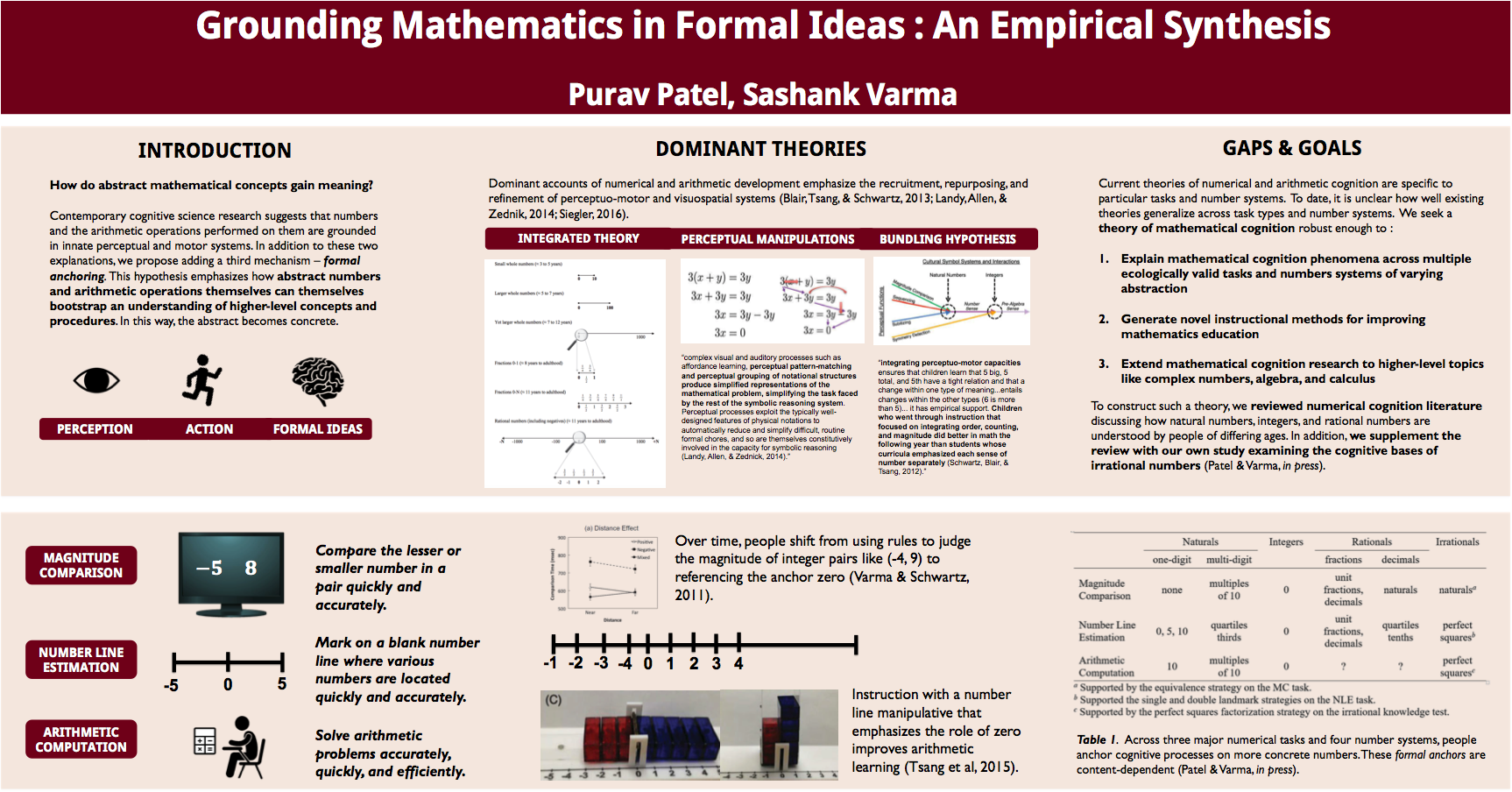 How do abstract mathematical concepts gain meaning? Contemporary cognitive science research suggests that numbers and the arithmetic operations performed on them are grounded in innate perceptual and motor systems. In addition to these two explanations, we propose adding a third mechanism – formal anchoring. This hypothesis emphasizes how abstract numbers and arithmetic operations themselves can themselves bootstrap an understanding of higher-level concepts and procedures. In this way, the abstract becomes concrete.
How do abstract mathematical concepts gain meaning? Contemporary cognitive science research suggests that numbers and the arithmetic operations performed on them are grounded in innate perceptual and motor systems. In addition to these two explanations, we propose adding a third mechanism – formal anchoring. This hypothesis emphasizes how abstract numbers and arithmetic operations themselves can themselves bootstrap an understanding of higher-level concepts and procedures. In this way, the abstract becomes concrete.
"The Legal Implications of Detecting Alzheimer's Disease Earlier" - Joshua Preston, et al. (400kb pptx)
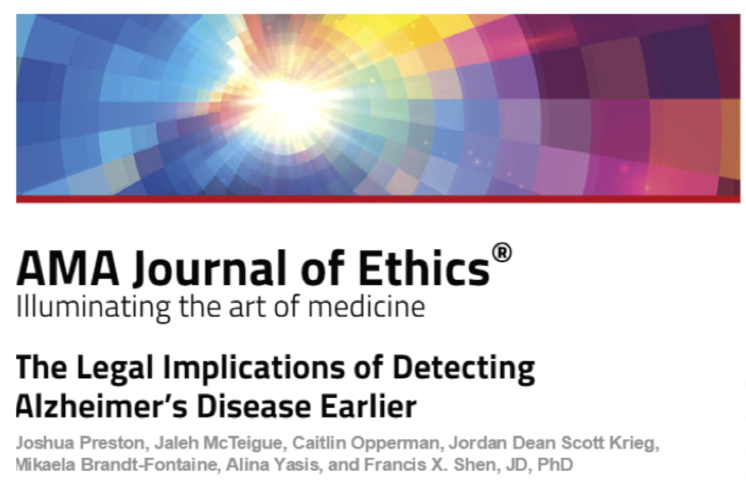 Early detection of Alzheimer's disease (AD) raises a number of challenging legal questions. In this essay, we explore some of those questions, such as: Is a neurological indicator of increased risk for AD a legally relevant brain state before there are any outward behavioral manifestations? How should courts address evidentiary challenges to the admissibility of AD-related neuroimaging? How should the government regulate the marketing of neuroimaging diagnostic tools? How should insurance coverage for the use of these new tools be optimixed? We suggest that many voices and multidisciplinary perspectives are needed to answer these questions and ensure that legal responses are swift, efficient, and equitable.
Early detection of Alzheimer's disease (AD) raises a number of challenging legal questions. In this essay, we explore some of those questions, such as: Is a neurological indicator of increased risk for AD a legally relevant brain state before there are any outward behavioral manifestations? How should courts address evidentiary challenges to the admissibility of AD-related neuroimaging? How should the government regulate the marketing of neuroimaging diagnostic tools? How should insurance coverage for the use of these new tools be optimixed? We suggest that many voices and multidisciplinary perspectives are needed to answer these questions and ensure that legal responses are swift, efficient, and equitable.
"Interpretations of Nonstandard Capitalization on Twitter" - Maria Heath (657kb pptx)
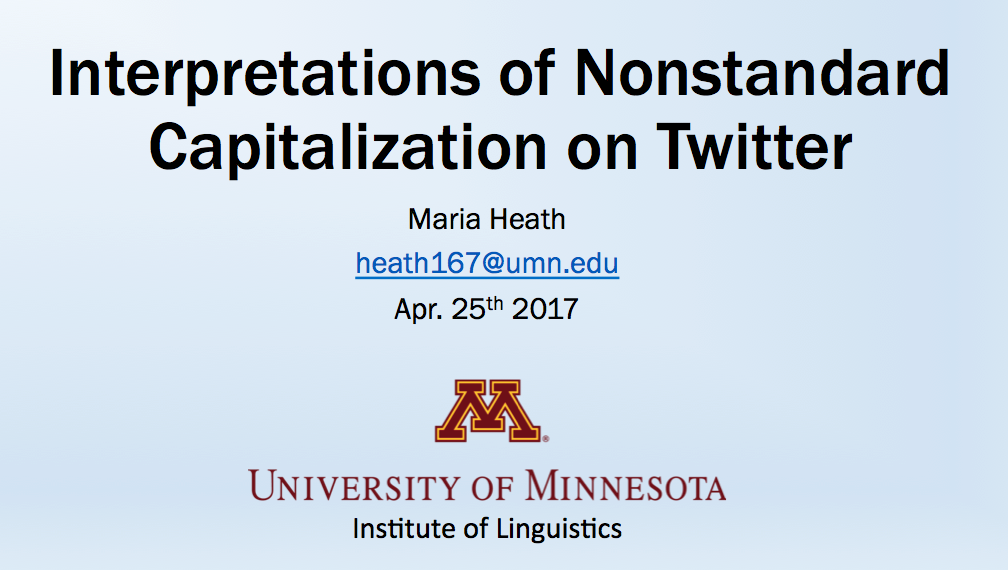 The “caps lock” pattern contributes to meaning of messages in social media. Including this capitalization can intensify happiness. This effect may be due to parallels with prosody in oral language. A number of other orthographics may influence reader interpretation of text on social media, and these factors merit further research.
The “caps lock” pattern contributes to meaning of messages in social media. Including this capitalization can intensify happiness. This effect may be due to parallels with prosody in oral language. A number of other orthographics may influence reader interpretation of text on social media, and these factors merit further research.
"The relation between withdrawal-potentiated startle and morphine self administration in rats" - Mari Gades (1.25mb pptx)
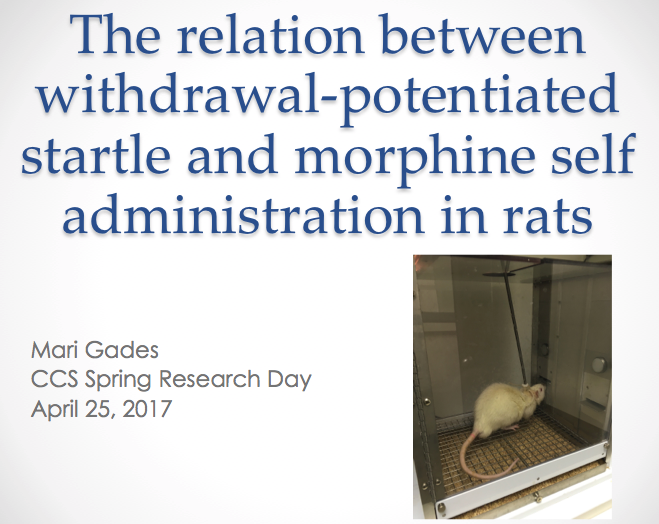 I have chosen to study withdrawal potentiated acoustic startle as my predictor of future drug abuse. This is a measure of anxiety, often used in human studies of PTSD. Rat acoustic startle is a little different. We put them in a small chamber in a sound attenuated box, as shown here. The rat will be sitting on metal bars that are attached to an accelerometer to measure movement. Then, we give short white noise bursts at varying decibel levels—we use 95, 100, and 105—to measure startle before drug—or baseline—and during withdrawal. I look at two different types of withdrawal. First, there is spontaneous withdrawal, when we allow an animal to go through withdrawal over time. This peaks at about three hours in rats. There is also precipitated withdrawal, during which we give an animal a drug and then when the drug has saturated the system we precipitate, or bring on, withdrawal through giving an antagonist, in this case naloxone (which some people may know as narcan). To get our measurements of startle, we look at how much an individual animal’s startle changes in amplitude from baseline to withdrawal.
I have chosen to study withdrawal potentiated acoustic startle as my predictor of future drug abuse. This is a measure of anxiety, often used in human studies of PTSD. Rat acoustic startle is a little different. We put them in a small chamber in a sound attenuated box, as shown here. The rat will be sitting on metal bars that are attached to an accelerometer to measure movement. Then, we give short white noise bursts at varying decibel levels—we use 95, 100, and 105—to measure startle before drug—or baseline—and during withdrawal. I look at two different types of withdrawal. First, there is spontaneous withdrawal, when we allow an animal to go through withdrawal over time. This peaks at about three hours in rats. There is also precipitated withdrawal, during which we give an animal a drug and then when the drug has saturated the system we precipitate, or bring on, withdrawal through giving an antagonist, in this case naloxone (which some people may know as narcan). To get our measurements of startle, we look at how much an individual animal’s startle changes in amplitude from baseline to withdrawal.
"Bayesian Neuroscience of Psychedelic Drugs" - Link Swanson (5mb pdf)
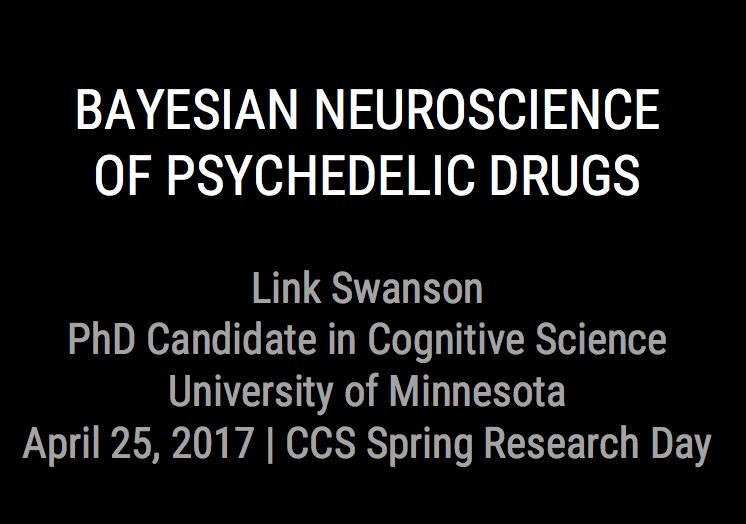 We argue that a Bayesian predictive processing account of brain function is a useful framework for developing an integrated, multi-level neuroscience of psychedelic drugs, spanning receptor pharmacology, neuroanatomy, computation, cognition, and phenomenology. The paper extends Bayesian interpretations of drug models of clinical psychosis (delusions and hallucinations) to psychedelic neuroscience. Paradigm perceptual and cognitive effects of serotonergic psychedelics (LSD, psilocybin, DMT) are interpreted within the predictive processing framework. Future research and methodological issues inspired by the framework are considered.
We argue that a Bayesian predictive processing account of brain function is a useful framework for developing an integrated, multi-level neuroscience of psychedelic drugs, spanning receptor pharmacology, neuroanatomy, computation, cognition, and phenomenology. The paper extends Bayesian interpretations of drug models of clinical psychosis (delusions and hallucinations) to psychedelic neuroscience. Paradigm perceptual and cognitive effects of serotonergic psychedelics (LSD, psilocybin, DMT) are interpreted within the predictive processing framework. Future research and methodological issues inspired by the framework are considered.
